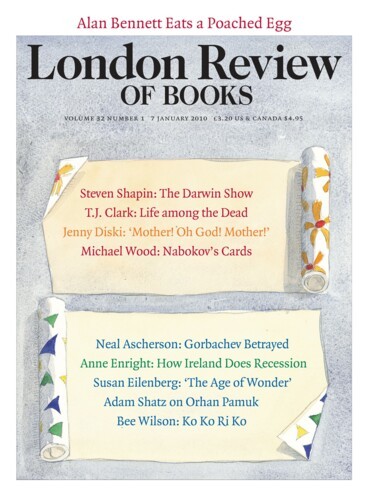In an experiment reported many years ago a pencil of light was shone through a tank. The resident goldfish chose to swim back and forth through the beam. This was interpreted as evidence of an appetite, perhaps a need, for sensory stimulation. If it could, the goldfish too might pay good money to be dropped from a great height or whirled through the air. Fairground music and flashing lights add to the experience of the big wheel, the long fall, the carousel, the dodgem and the rollercoaster, but they aren’t essential: bungee jumpers take the drop with no more than the cheers of friends, and skiers slide down mountains in silence.
In Winter Wonderland in Hyde Park until 3 January a full range of kinetic pleasures is available. The 66-metre Power Tower offers the simplest, free fall: you are strapped into a seat, hauled to the top of the tower and dropped. Rollercoasters transfer g-force through various degrees of torque, and the ancient thrill of a fast glide is available on the ice rink. If you want a fearful thrill of another sort there are various chambers that promise unnamed horrors (while signalling that it’s all a joke). At night, when bright lights on roundabouts and rides are all you can see, when the smell of onions and sausages from stalls in the German Market activates another set of sensory receptors, the daytime world is lost in the surrounding darkness. If you are too poor or timid (or, in my case, old and creaky) to try the attractions you can still watch.
Watching other human beings challenge gravity is not a new sport. The crowds who gathered to see the first ascents by balloon were immense: many paid to be close to the launch, even though the balloon would rise quickly and be visible almost at once to any who cared to look up. The absurd death that was the fate of a man who tried, and failed, to fly from the Eiffel Tower was caught by an early cinematographer. Over the decades, equally absurd but, astonishingly, not always fatal trips by barrel over Niagara Falls have been a regular crowd-pleasing event. Images of floating astronauts have done more for the public acceptance of Nasa’s budgets than zero-gravity scientific experiments. A couple of hundred thousand dollars will now buy you the promise of a trip on Virgin Galactic’s SpaceShipTwo.
After a morning among the rides in Hyde Park I went to catch the last days of the Anish Kapoor exhibition at the Royal Academy. A long queue led to galleries where it was easy to feel you were among a fairground crowd, or visitors to a natural phenomenon – a geyser, say – or a group seeing off an early balloonist. The atmosphere was cheerful, there were smiles, even laughter. Nobody asked what it all meant. Kapoor’s huge, trundling block of red wax is drawn very, very slowly through the high arched doorways of the main galleries; his pneumatic canon launches wet red projectiles into the corner of another gallery; tall mirrored slabs curve to enlarge or reduce the passer-by; close-spaced palettes are loaded waist-high with piles of grey gut-like extrusions. None of these makes a claim on sentiment or intellect.
Nor, of course, does the Power Tower. But the fairground supplies higher peaks of raw sensation: you hear it in the shrieks from the big dipper and squeals from the ghost house, you see it in the tears of the children who want to escape from the merry-go-round. When art is pushed into finding its audience among those with an appetite for pure sensation – not just the gross sensations of the paint-filled pop gun but the quieter but still content-free manifestations of the higher fairground art in the Turbine Hall in Tate Modern – it invites comparison with the aspects of reality that in the past would have been called sublime. To enter into direct competition with a big waterfall, or the excavations of an iron ore mine, or a blast furnace seen by night, or (something I once saw) a whole factory hall stained by a dusting of blue pigment, is a challenge even large-scale land art can find it hard to meet. Kapoor’s polished steel sculptures are prodigies of industrial metalwork, and while part of the attraction of Richard Serra’s huge steel slabs comes from an awe like that one feels in treading the narrow defile of a river-cut canyon, the challenge they offer to ideas about the limits of human powers of fabrication is part of it too.
When visual art turns to the primitive fears and thrills of the fairground it pays for the strong sensations it offers by narrowing its intellectual range. Kapoor’s mirror sculptures bring to mind the ultimate in polished surfaces – the mirrors of great telescopes. The Hubble telescope’s view from beyond the veil of the atmosphere is perhaps the greatest gift space engineering has brought us – whether one thinks of it as science or as art. The Hubble mirror – even the drama of the error in its configuration that brought a human dimension to the story – is, like Kapoor’s metal sculpture, a thing to wonder at. But the knowledge that it has been used to test ideas about the cosmos is part of that wonder. When it comes to ideas the fairground art of pure sensation hasn’t much to offer.
Send Letters To:
The Editor
London Review of Books,
28 Little Russell Street
London, WC1A 2HN
letters@lrb.co.uk
Please include name, address, and a telephone number.



